
Chasing Winter
Scientists call the Alaska “ground zero” for climate change, and last year was the state’s warmest on record. Alaska is at the front line of climate change and what is happening to villages across the region can be seen as early indications for the rest of the world’s future. “Chasing Winter” explores how this reality is transforming the relationship between people, animals, and the land.
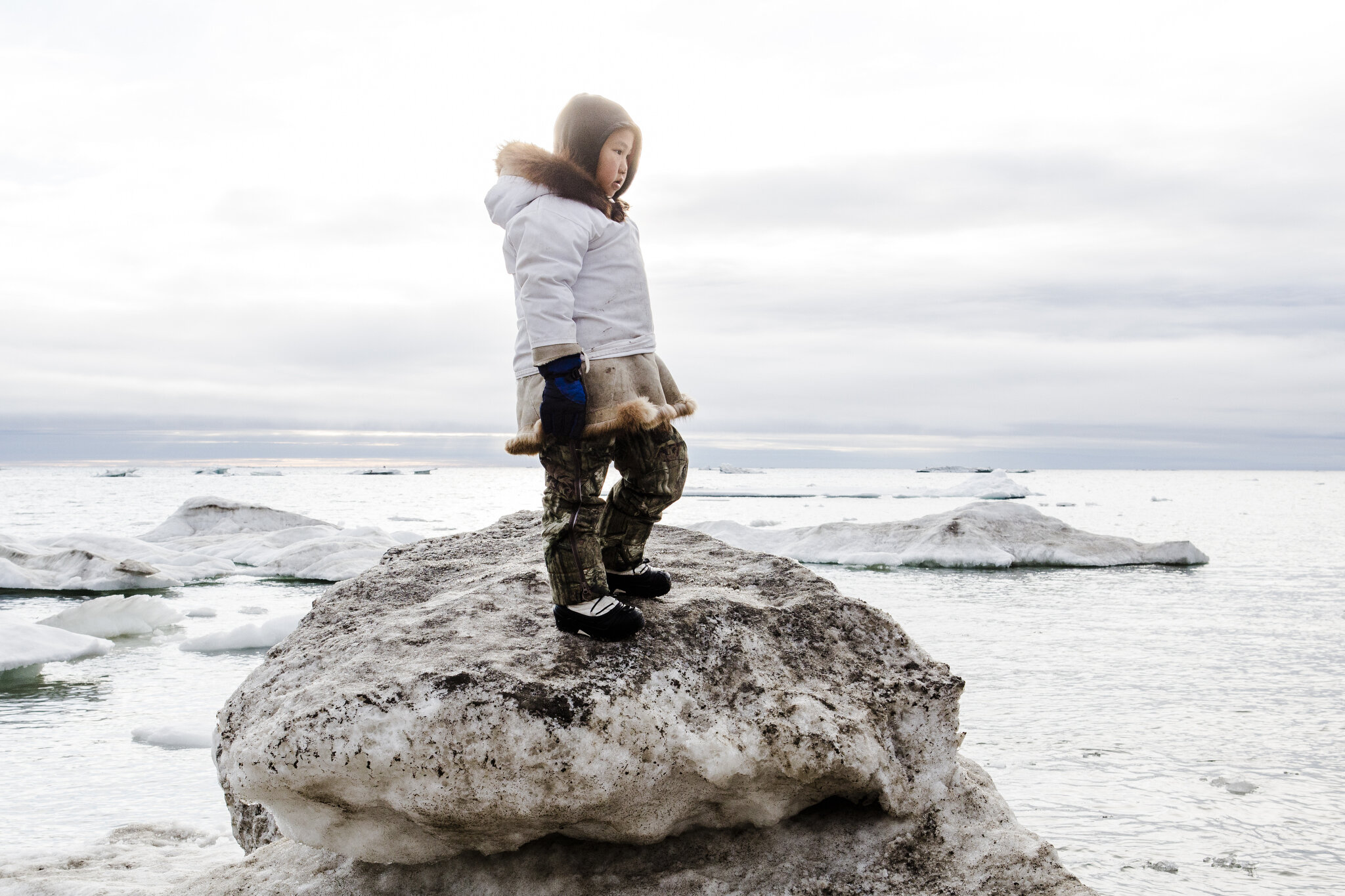
Leo Sage returns to town in Utqiagvik, Alaska, after hunting bearded seals with his father by boat in the Arctic Ocean. They were unsuccessful. June 27th, 2015. July 2019 was officially the warmest month in Alaskan history, and Utqiagvik, the northernmost town in the United States, has been labeled “ground zero for climate change.” A child’s first seal hunt is an important rite of passage, especially now as these traditions are being challenged as a result of climate change. For thousands of years, Inupiat villagers along Alaska’s North Slope have hunted marine mammals such as seal, walrus, and whale. Hunting, fishing, and foraging for food, known as subsistence, remains one of the most significant aspects of life in Inupiat communities.
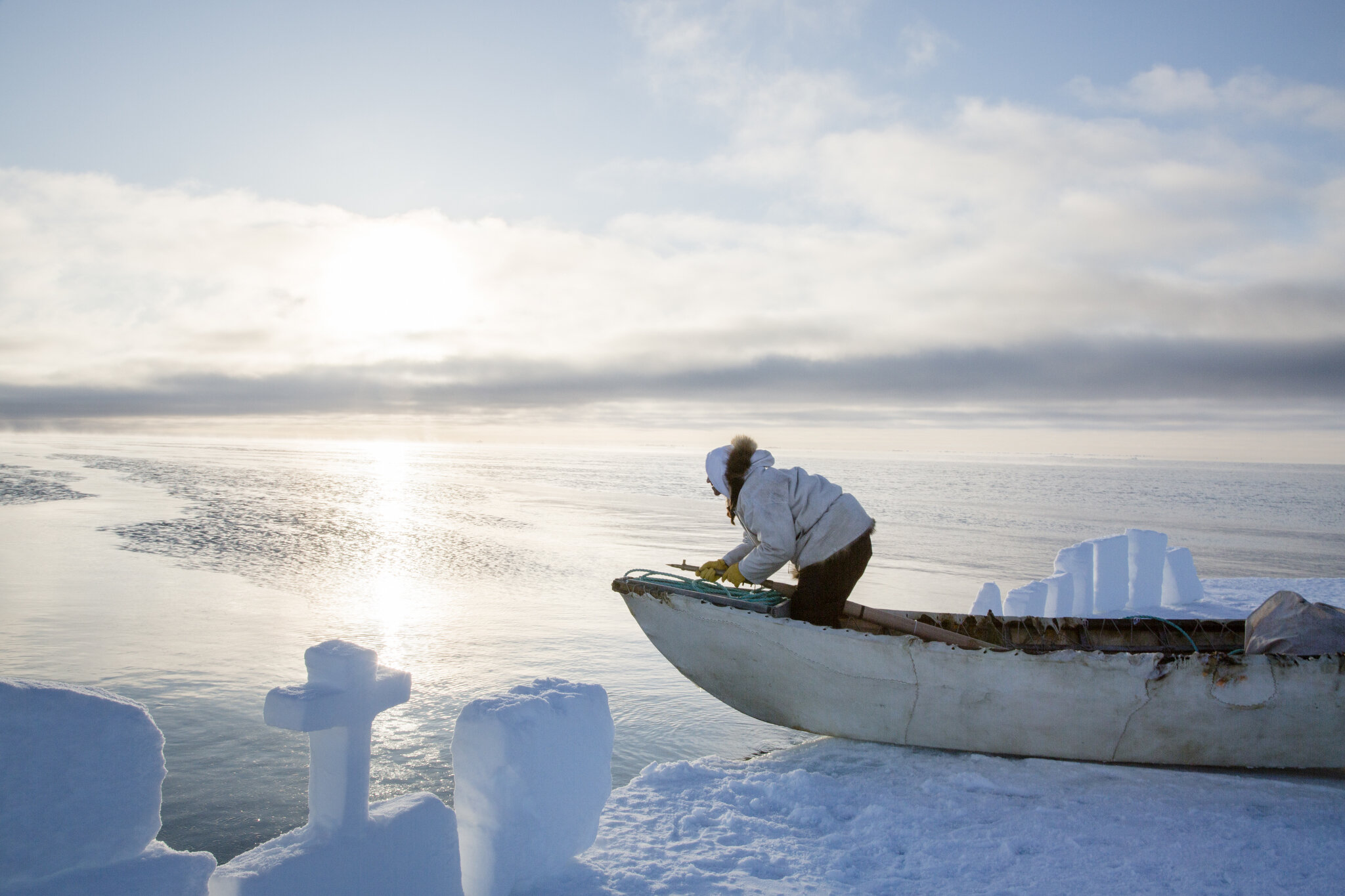
The annual spring bowhead whale hunt in Barrow, Alaska in April, 2016. Here Iñupiat harpooner and whaling captain Quincy Adams surveys the horizon for bowhead whales in a traditional sealskin canoe. Together with his crew, he camps out on the sea ice outside of Barrow, Alaska for weeks on end waiting for the “gift of the whale.” Quincy himself made the cross to add to this snow wall, a type of camouflage for the hunters to conceal themselves from whales swimming by, but also an apt metaphor for the all-encompassing significance of whaling in in Inupiaq communities. Almost the entire village of Barrow participates in the annual spring whale hunt in some way, either as part of a whaling crew or assisting the massive effort of butchering, transporting and processing the thousand pound mammal. Safely storing the meat from a one hundred ton massive animal is a crucial part of the process. These whales are expected to feed the community for the entire year to come, but this ancient practice is now threatened by thawing permafrost and climate change. Ice cellars-underground freezers that were carved generations ago into what used to be permanently frozen ground-are melting and completely destroyed by flooding. Others have been rendered unusable, causing the whale meat and other crucial hunted foods to spoil. Whaling, hunting, fishing and foraging for food (known as subsistence) is not only crucial as the main food source for inupiat communities; it is one of the most important aspects of cultural, spiritual and everyday life.
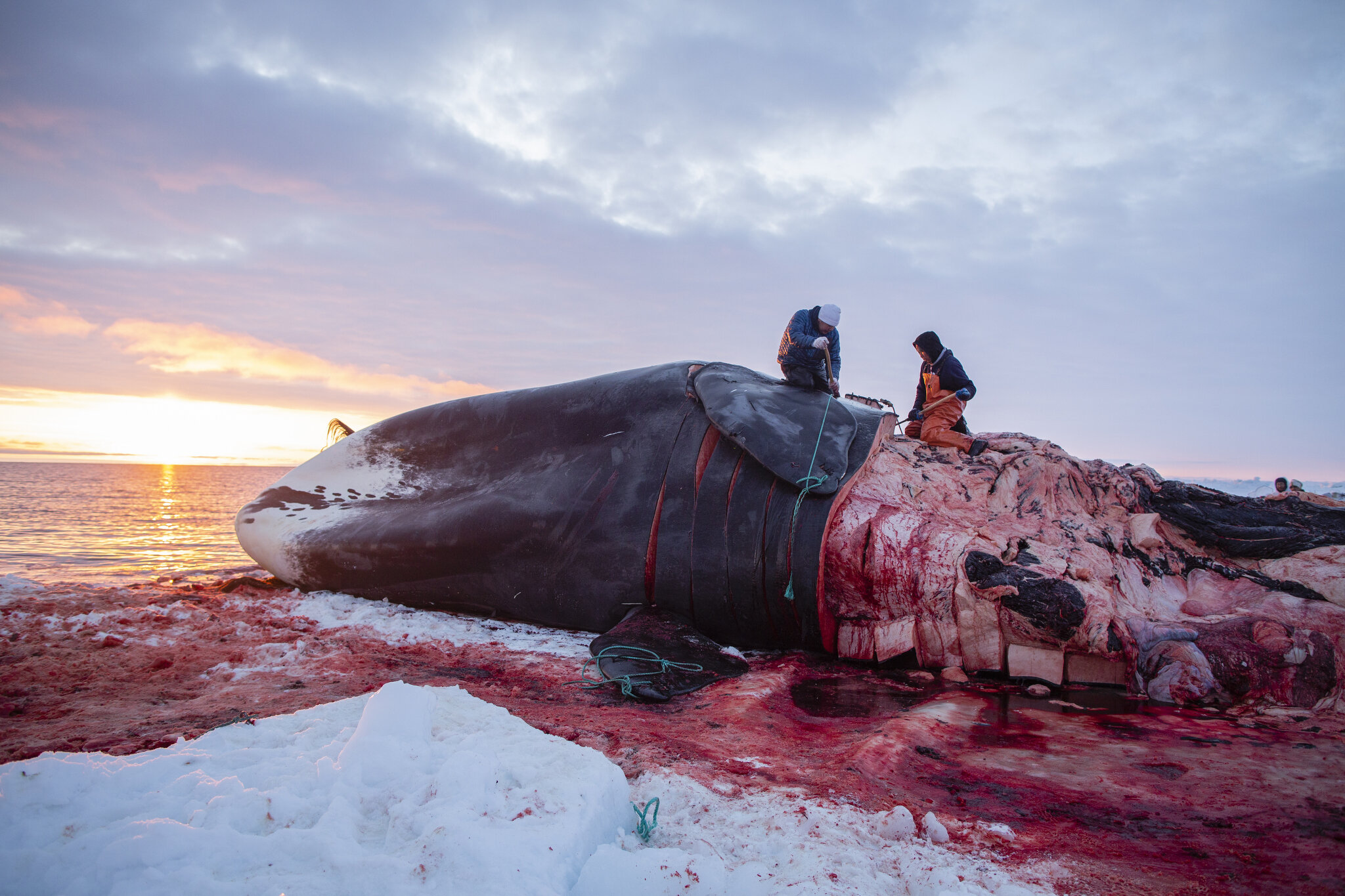
A roughly fifty-foot bowhead whale is caught during spring whaling in Utqiaġvik, Alaska. May 5th, 2016. Almost the entire village of Utqiaġvik participates in the annual spring whale hunt in some way, either as part of a whaling crew or assisting the massive effort of butchering, transporting and processing the thousand pound mammal. Safely storing the meat from a one hundred ton massive animal is a crucial part of the process. These whales are expected to feed the community for the entire year to come, but this ancient practice is now threatened by thawing permafrost and climate change. Ice cellars-underground freezers that were carved generations ago into what used to be permanently frozen ground-are melting and completely destroyed by flooding. Others have been rendered unusable, causing the whale meat and other crucial hunted foods to spoil. Whaling, hunting, fishing and foraging for food (known as subsistence) is not only crucial as the main food source for Inupiat communities; it is one of the most important aspects of cultural, spiritual and everyday life.
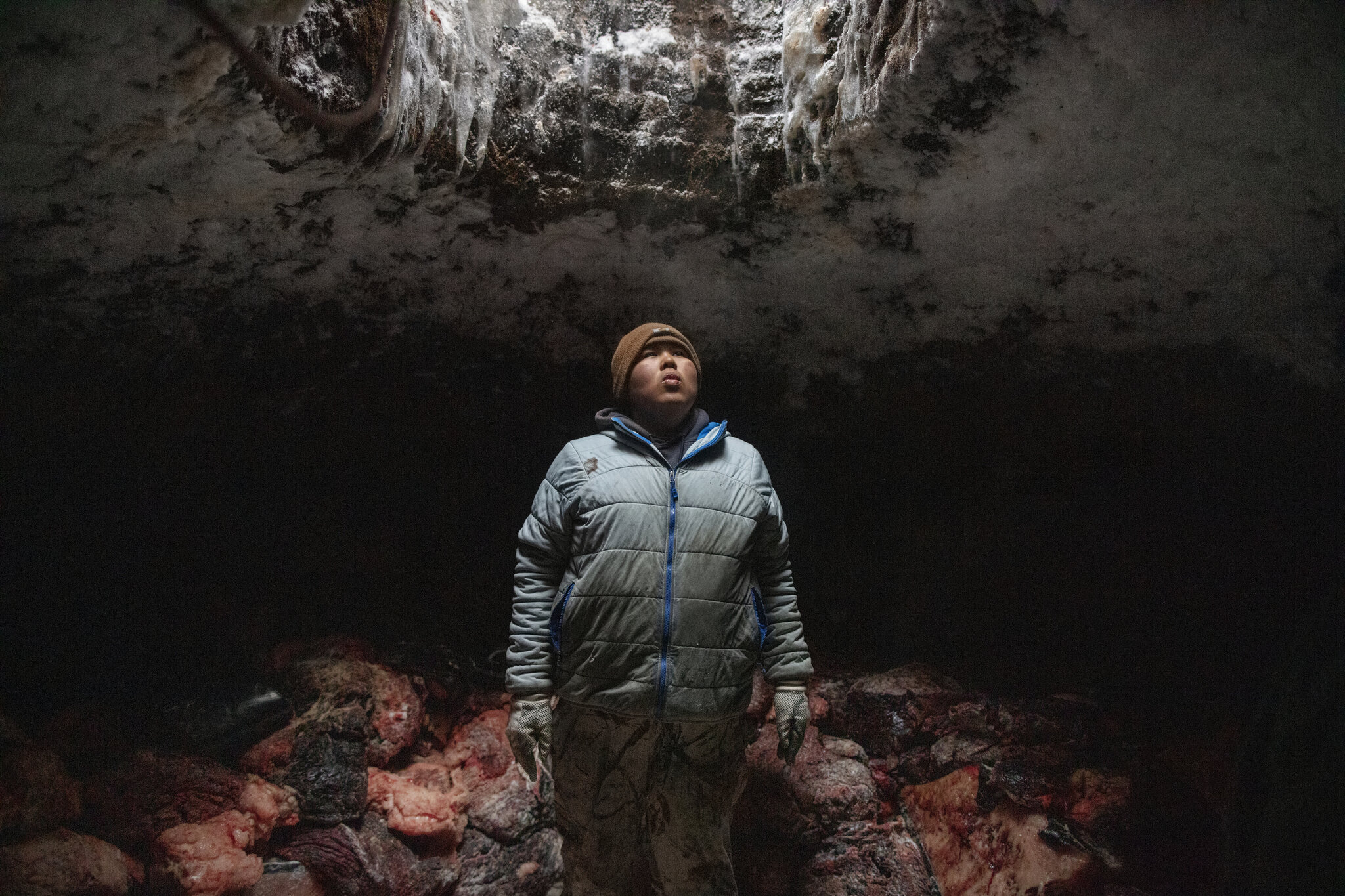
After a successful hunt, Josiah Olemaun, a young whaling crew member takes a break from moving and stacking whale meat into his family’s ice cellar in Utqiagvik, Alaska. April 29th, 2018. Ice cellars are generations-old massive underground freezers dug deep into the permafrost. As permafrost thaws it is wreaking havoc, melting what used to be permanently frozen ground and destroying and flooding many ice cellars. Others have warmed up to a point that they are unusable, spoiling whale meat and other crucial hunted foods.
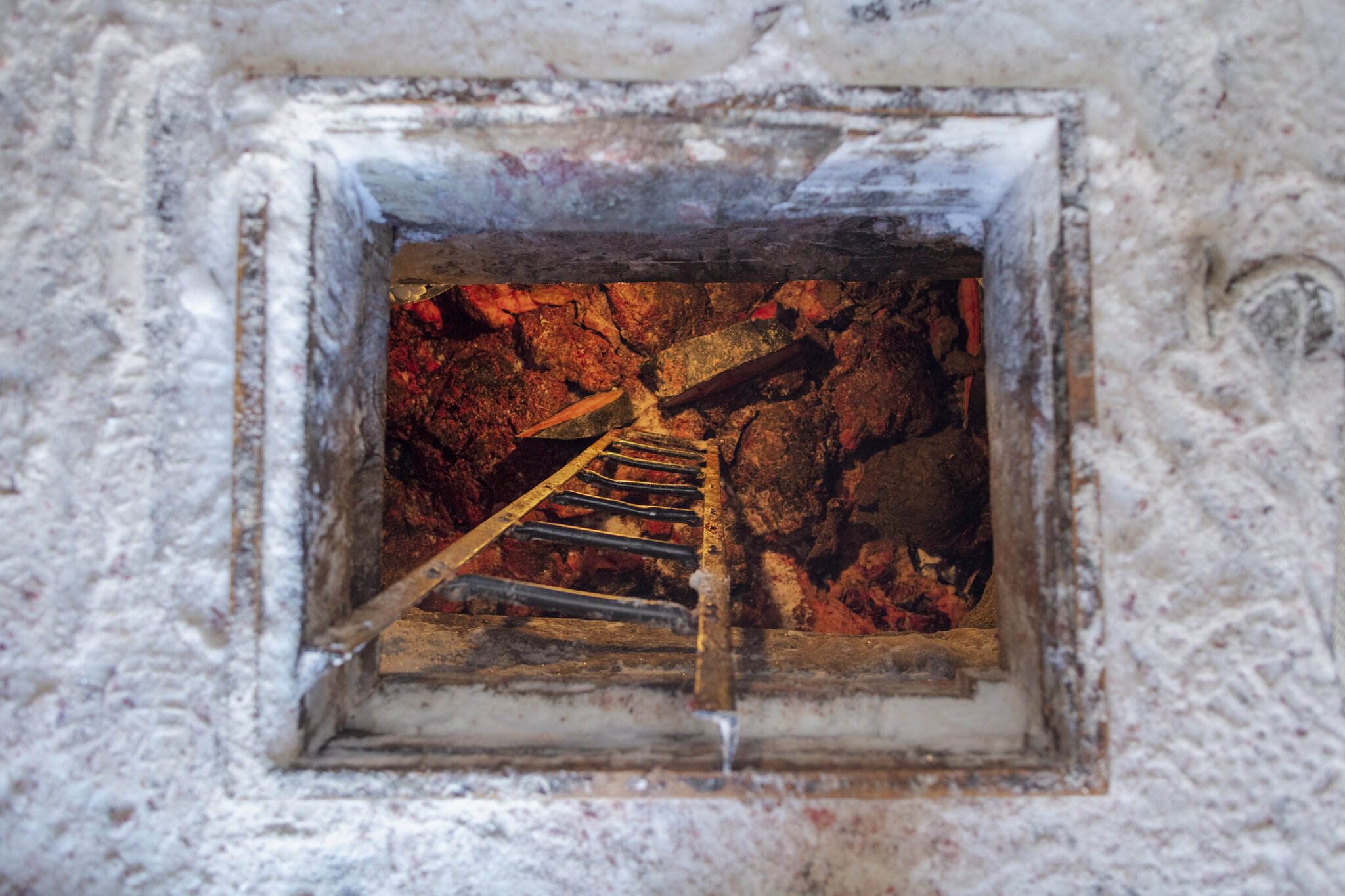
Whale meat in the Olemaun family’s ice cellar in Utqiagvik, Alaska. April 28th, 2018. For thousands of years, Inupiat villagers along Alaska’s North Slope have hunted bowhead whales. A single whale can feed a community for much of a year if the meat and blubber are properly stored, which traditionally has been done in ice cellars. Ice cellars are generations-old massive underground freezers dug deep into the permafrost. As permafrost thaws it is wreaking havoc, melting what used to be permanently frozen ground and destroying and flooding many ice cellars. Others have warmed up to a point that they are unusable, spoiling whale meat and other crucial hunted foods.

An adolescent polar bear grew tired of whale scraps, and made continuous attempts to eat a freshly caught whale in Barrow, Alaska as dozens of whalers and community members stood nearby. It was later shot and killed. Polar bears have grown increasingly hungry as melting sea ice affects their ability to hunt seals on the arctic ocean ice sheet. More and more bears are coming into whaling villages like Barrow, Alaska to feed off scraps and bones during the annual subsistence whale hunt. The massive influx of polar bears makes another issue in the community an even bigger issue-thawing permafrost destroying traditional ice cellars (generations-old massive underground freezers dug deep into the permafrost). Now, community members are forced to store their hunted food above ground which attracts bears. The more climate change forces polar bears to interact with humans, the more dangerous it is not only for humans, but the already vulnerable polar bear species, who will be shot and killed as self-protection.
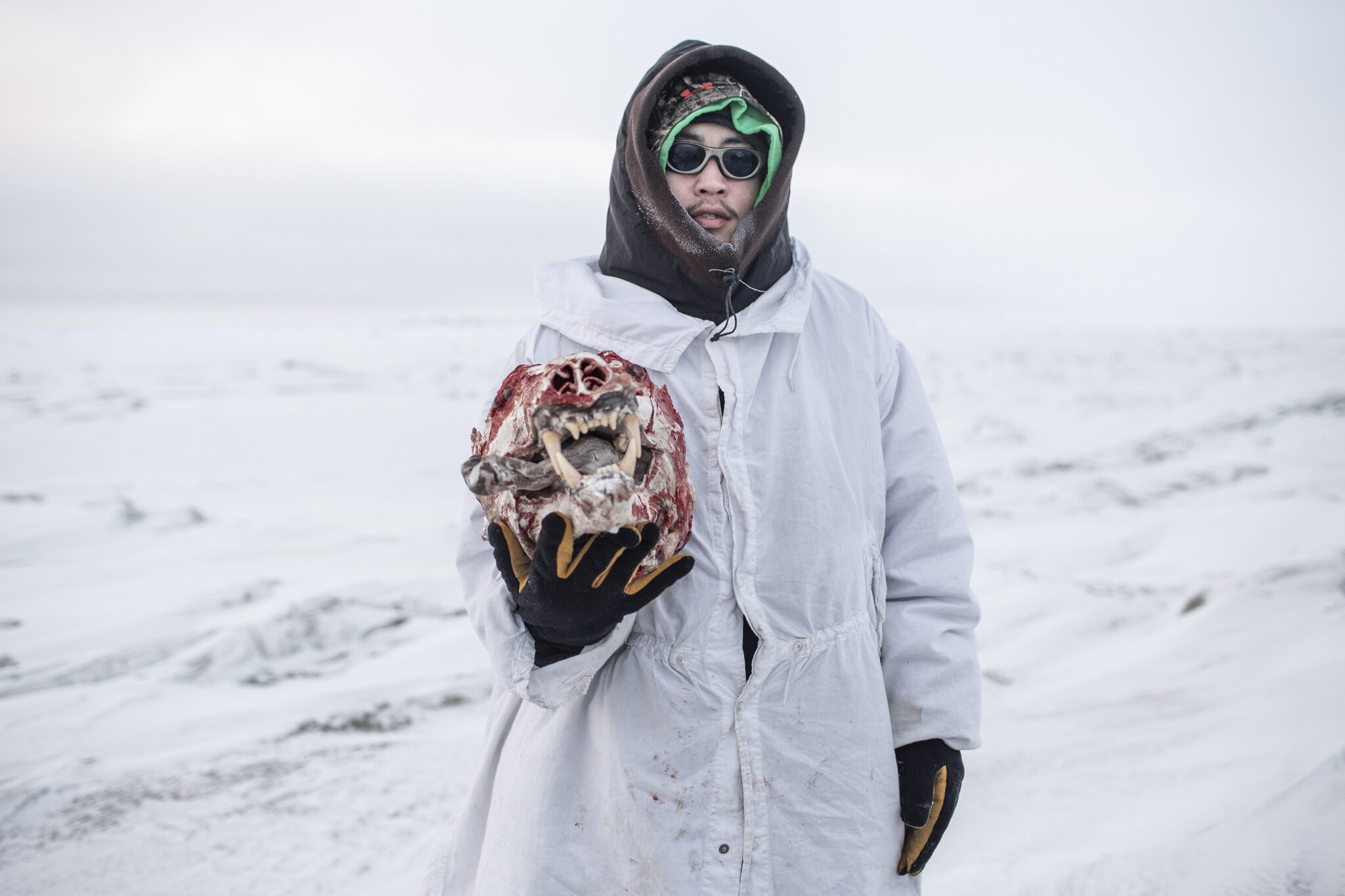
Nelson Nayokpuk of the Herman Ahsuak whaling crew in Utqiagvik, Alaska holds a polar bear skull they shot and killed the day before when it tried to eat their seal skin canoe. April 19th, 2016. Polar bears have grown increasingly hungry as melting sea ice affects their ability to hunt seals on the Arctic Ocean ice sheet. More and more bears are coming into whaling villages like Utqiagvik to feed off scraps and bones during the annual subsistence whale hunt. The massive influx of polar bears makes another issue in the community a larger issue-thawing permafrost destroying traditional ice cellars (generations-old massive underground freezers dug deep into the permafrost). Now, community members are forced to store their hunted food above ground, which attracts bears. The more climate change forces polar bears to interact with humans, the more dangerous it is not only for humans, but the already vulnerable polar bear species, who will be shot and killed as self-protection.
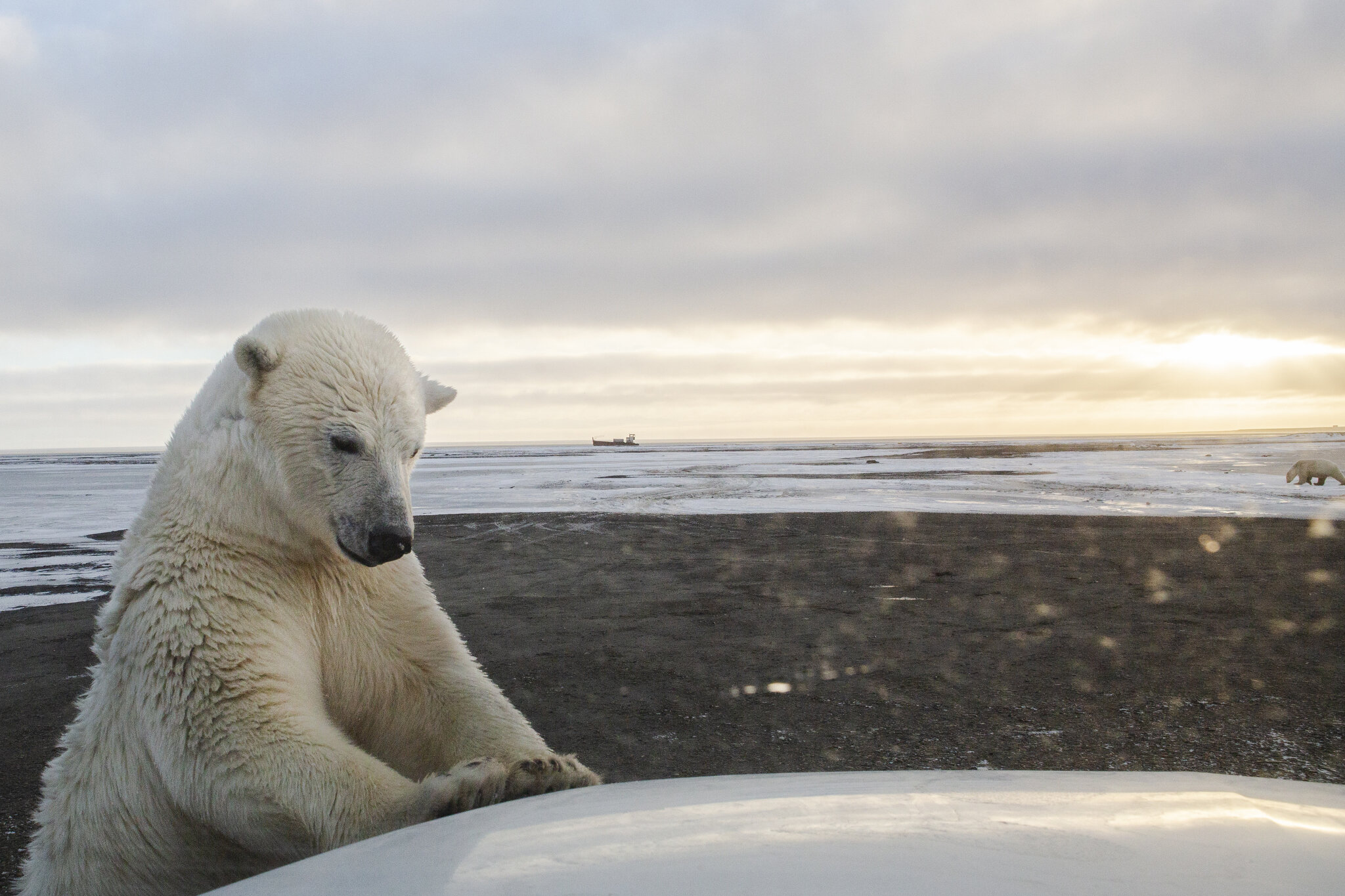
A curious teenage male polar bear investigates the hood of a truck in Kaktovik, Alaska, an Inupiat native village in the Alaskan Arctic. October 17th, 2015. Every fall after the Kaktovik community’s annual subsistence hunt of bowhead whales, more and more polar bears arrive to feed off the whale carcass' scraps and bones. Climate change has affected the migration and diet of polar bears, who have grown increasingly hungry as melting sea ice impairs their ability to hunt seals on the Arctic Ocean ice sheet. Meanwhile, scavenging so close to town brings its own set of challenges to both polar bears and the people of Kaktovik. With a steady stream of tourists and scientists coming to view and study the polar bears year after year, bears grow increasingly accustomed to interaction with humans.
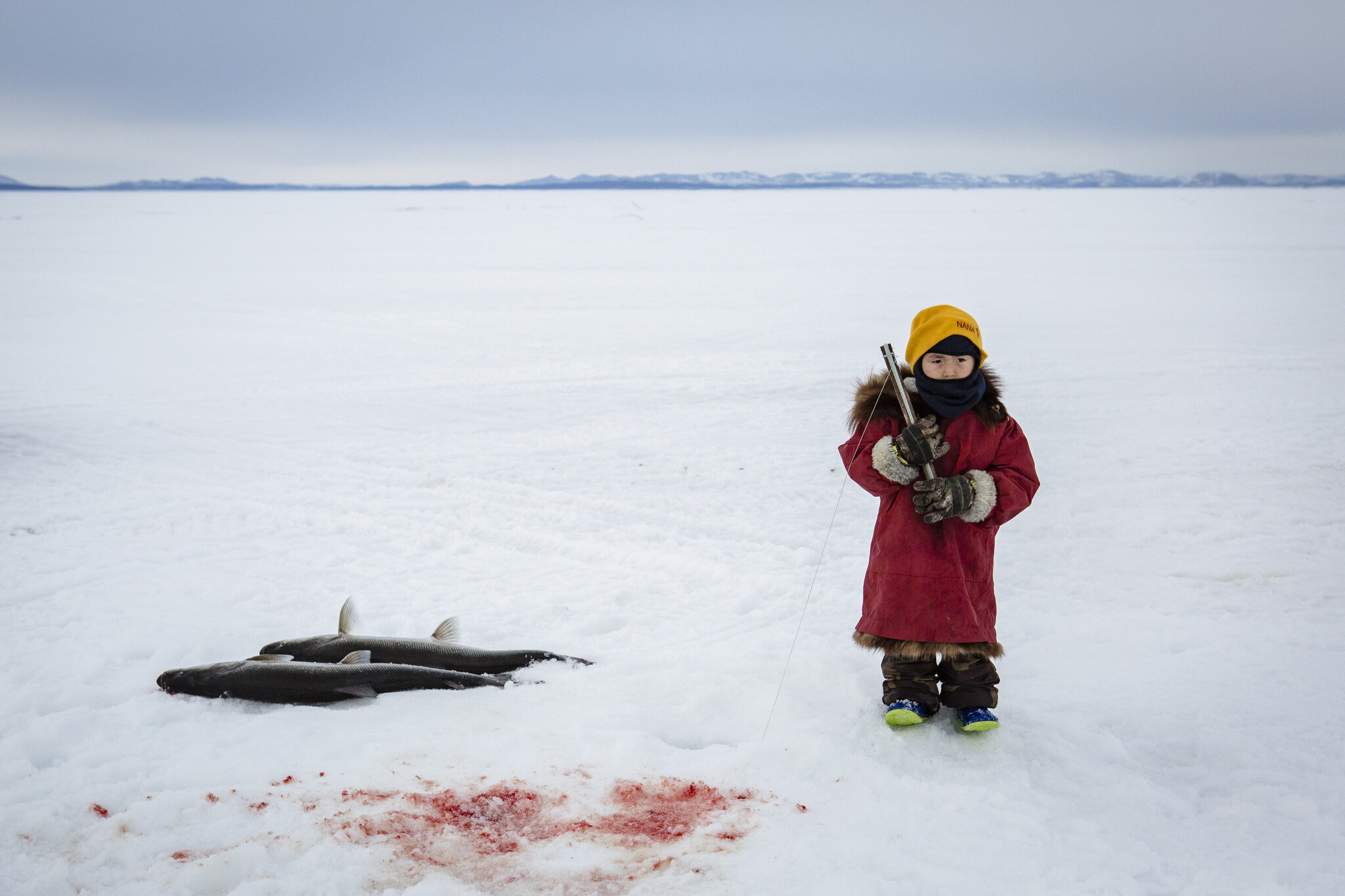
A young girl fishes on the frozen Kotzebue Sound in Kotzebue, Alaska. May 8th, 2015. In Kotzebue, Ice hole fishing for shellfish in the spring is both an important source of food and a popular past-time for Kotzebue residents. Sheefish are negatively impacted by permafrost thaw and river erosion, which is ever-increasing as a result of climate change. There is also a large crater nearby that is actively releasing sediment into shellfish spawning sites due to old buried glacier ice melting as a result of climate change. Kotzebue is facing serious infrastructure issues as a result of permafrost thaw and coastal erosion, as well as challenges to its residents' traditional subsistence hunting practices in the face of climate change. Hunting, fishing, and foraging for food are not only crucial as the main food sources for Inupiat communities in the Alaskan Arctic, they are the backbone of cultural, spiritual, and everyday life—and important rites of passage for children like this little girl.
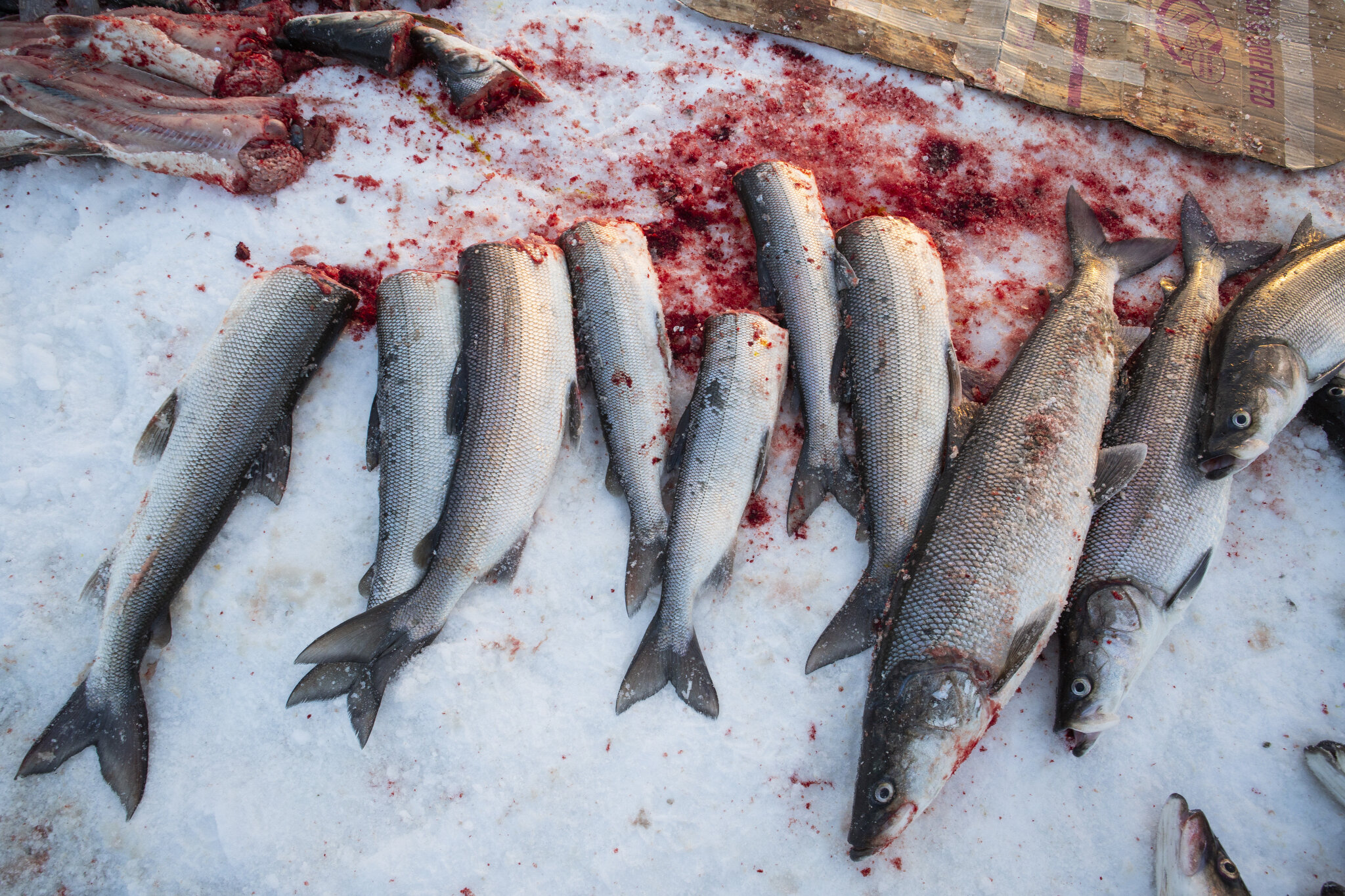
Sheefish on the frozen Kotzebue Sound in May 2015. Ice hole fishing is a popular past-time and these large fish are an important source of food for people in Kotzebue. Sheefish are under threat however as a result of a large crater releasing sediment into their spawning sites which is caused by old buried glacier ice melting as a result of climate change. Permafrost thaw and river erosion contribute to the problem. Kotzebue is one of Alaska’s largest predominantly Inupiaq native communities with a population of over 3,000 people. It is the main transportation and commerce hub for the entire Northwest Arctic region. Kotzebue faces large infrastructure issues as a result of permafrost thaw and coastal erosion, and challenges to its subsistence hunting traditions that are affecting communities across the Arctic (Kotzebue was visited by former President Obama during his trip to Alaska to highlight climate change).
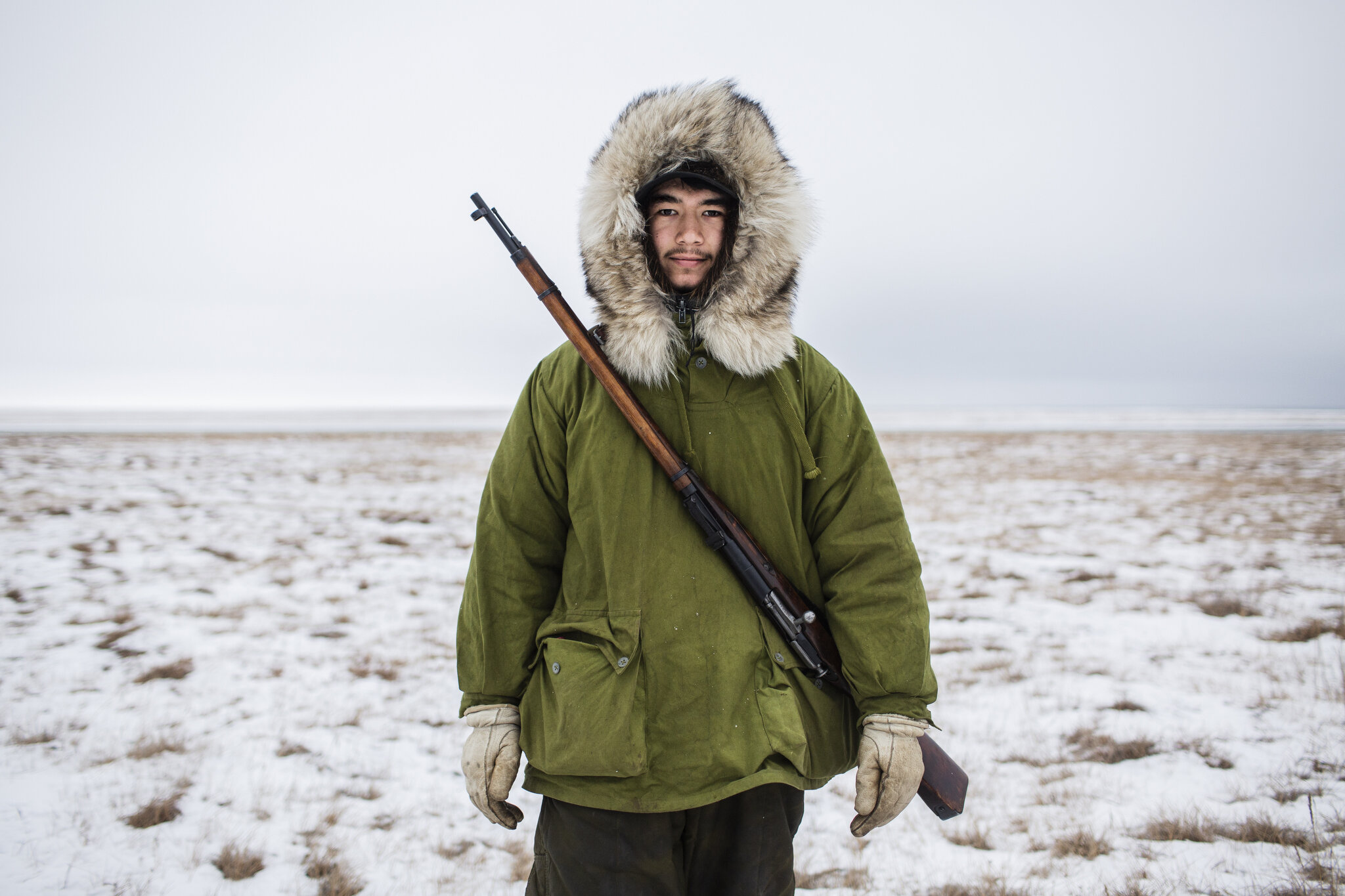
Vebjørn Aishana Reitan prepares to hunt caribou in Kaktovik, Alaska, an Iñupiat village on the coast of the Beaufort Sea located within the Arctic Wildlife Refuge. October 18th, 2015. The Refuge is currently in danger of being opened up to gas and oil drilling. This not only threatens the 200,000 caribou that calve and raise their young there, but the people who rely on them. For Iñupiat and Gwich'in communities, subsistence hunting is not only a source of food, but a tradition that is crucial to their cultural, spiritual and everyday life.
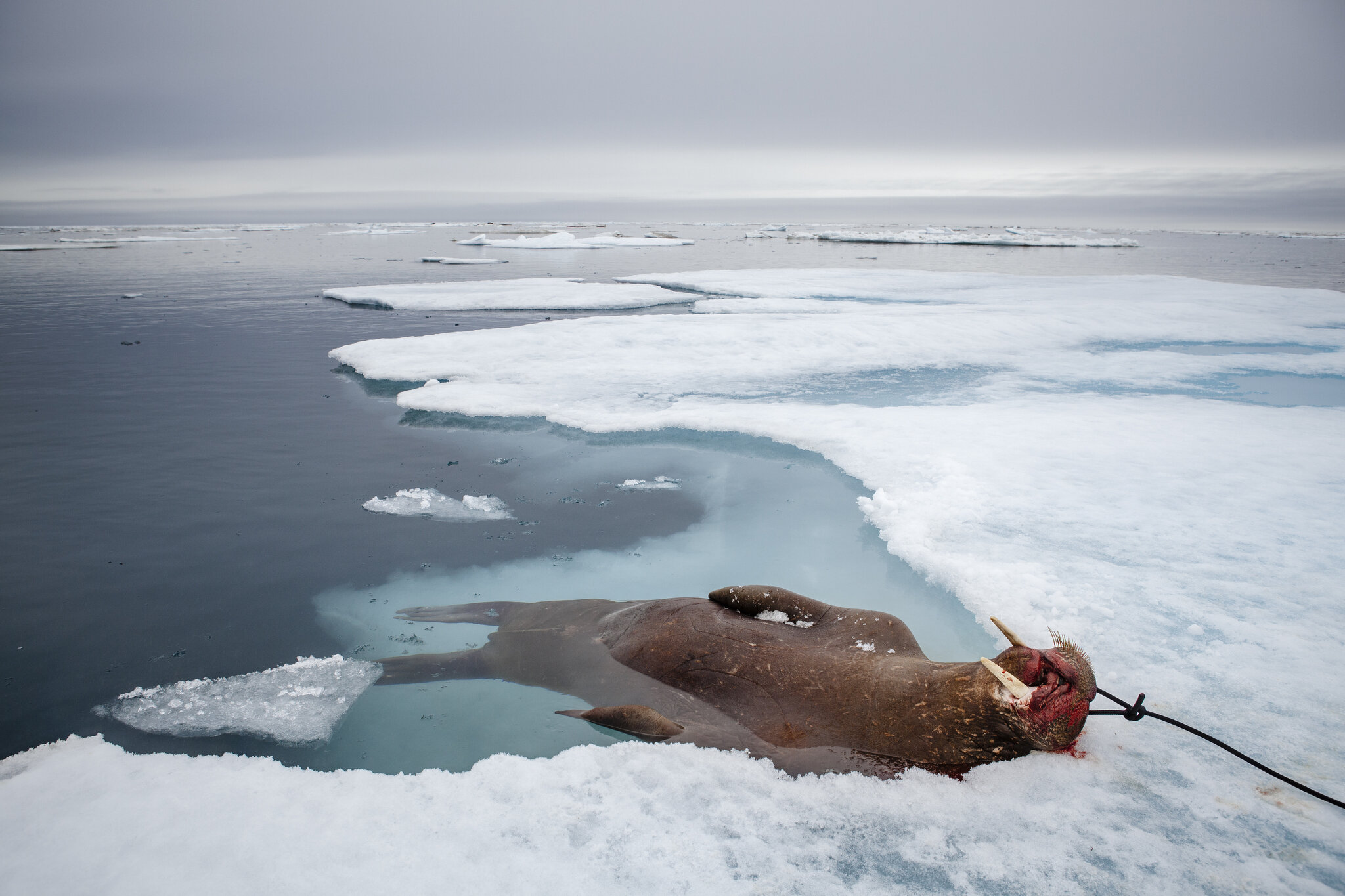
An Inupiat family hunts a walrus on the sea ice in the Arctic Ocean near Utqiagvik, Alaska (formerly known as Barrow). June 6th, 2015. Hunting affects all aspects of life, and is an important food source for this community. June used to be seal hunting season, but in 2015 hunters were seeing mostly walrus instead, which local scientists and hunters told me was rare that time of year and most likely due to warming weather changing migration patterns.
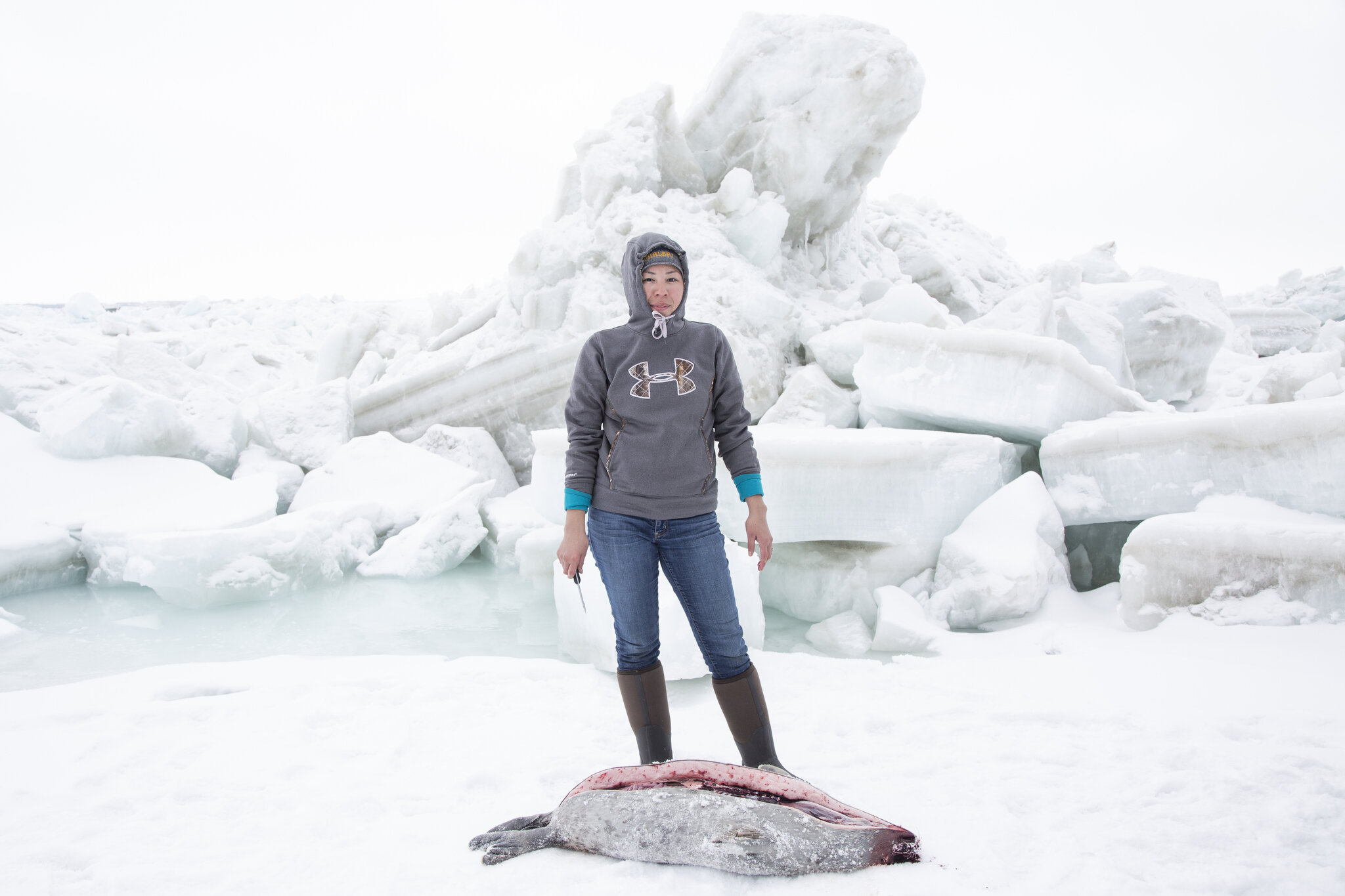
Flora Aiken processes a seal near Utqiaġvik (formerly known as Barrow), Alaska. April 27th, 2016. Hunting is an important rite of passage for the Inupiat families of the Alaskan Arctic, especially as these traditions are at an even greater risk of disappearing because of climate change. Whaling, hunting, fishing, and foraging for food (known as subsistence) is not only crucial as a food source for remote Inupiat communities, it is one of the most important aspects of cultural, spiritual, and everyday life. Traditionally hunting was a gendered activity, with women focused more on processing, cooking, and foraging, but that has all changed; as climate change and modernization undermine Inupiat subsistence practices, more women are engaging in them at every step to help keep traditions alive.
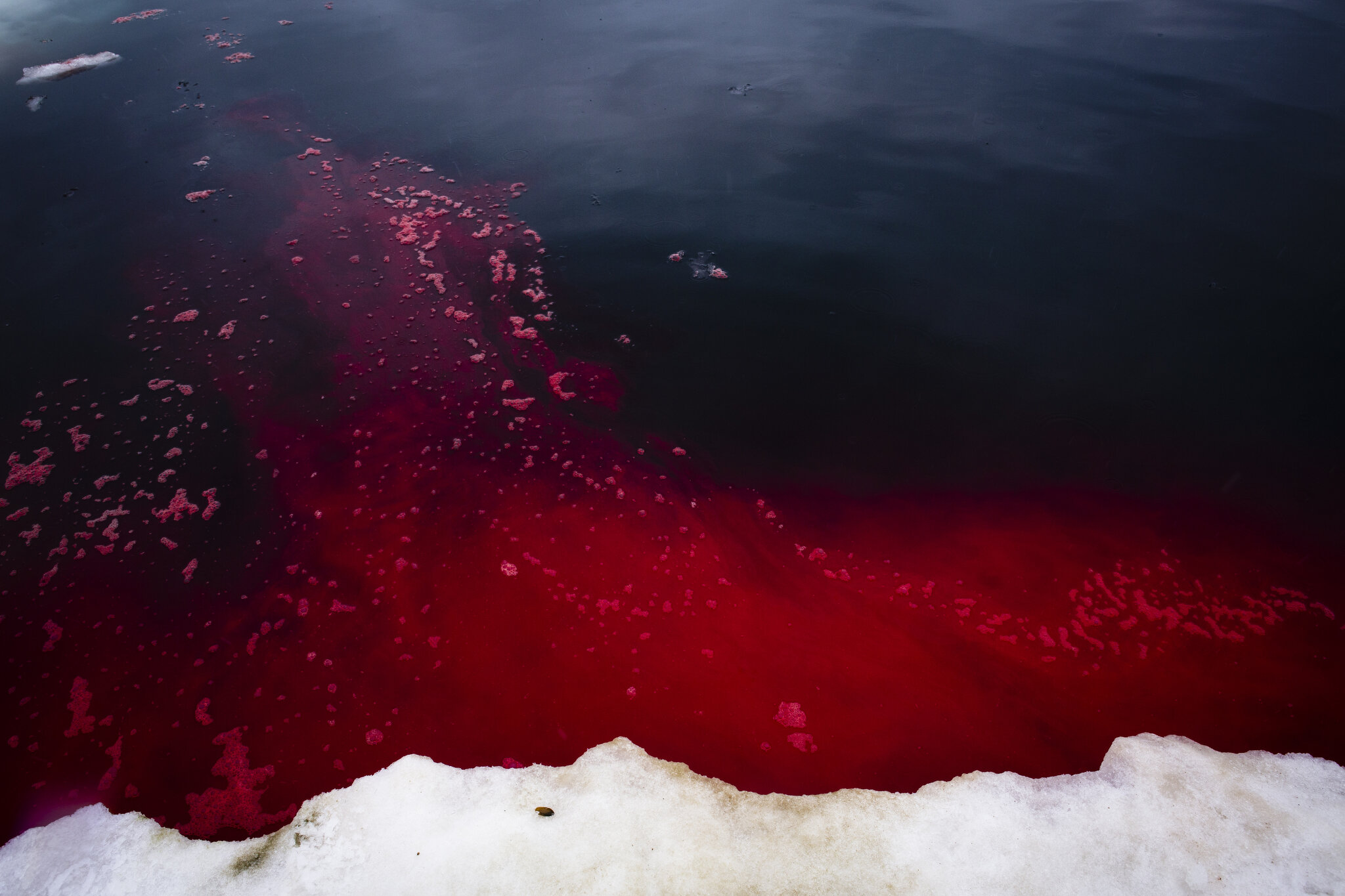
Walrus blood in the Arctic Ocean after an Inupiat family hunts a walrus on the sea ice near Utqiagvik, Alaska (formerly known as Barrow). June 25th, 2015. Hunting affects all aspects of life in Barrow, and is an important food source for this community. June used to be seal hunting season, but in 2015 hunters were seeing mostly walrus instead, which local scientists and hunters told me was rare that time of year and most likely due to warming weather changing migration patterns.
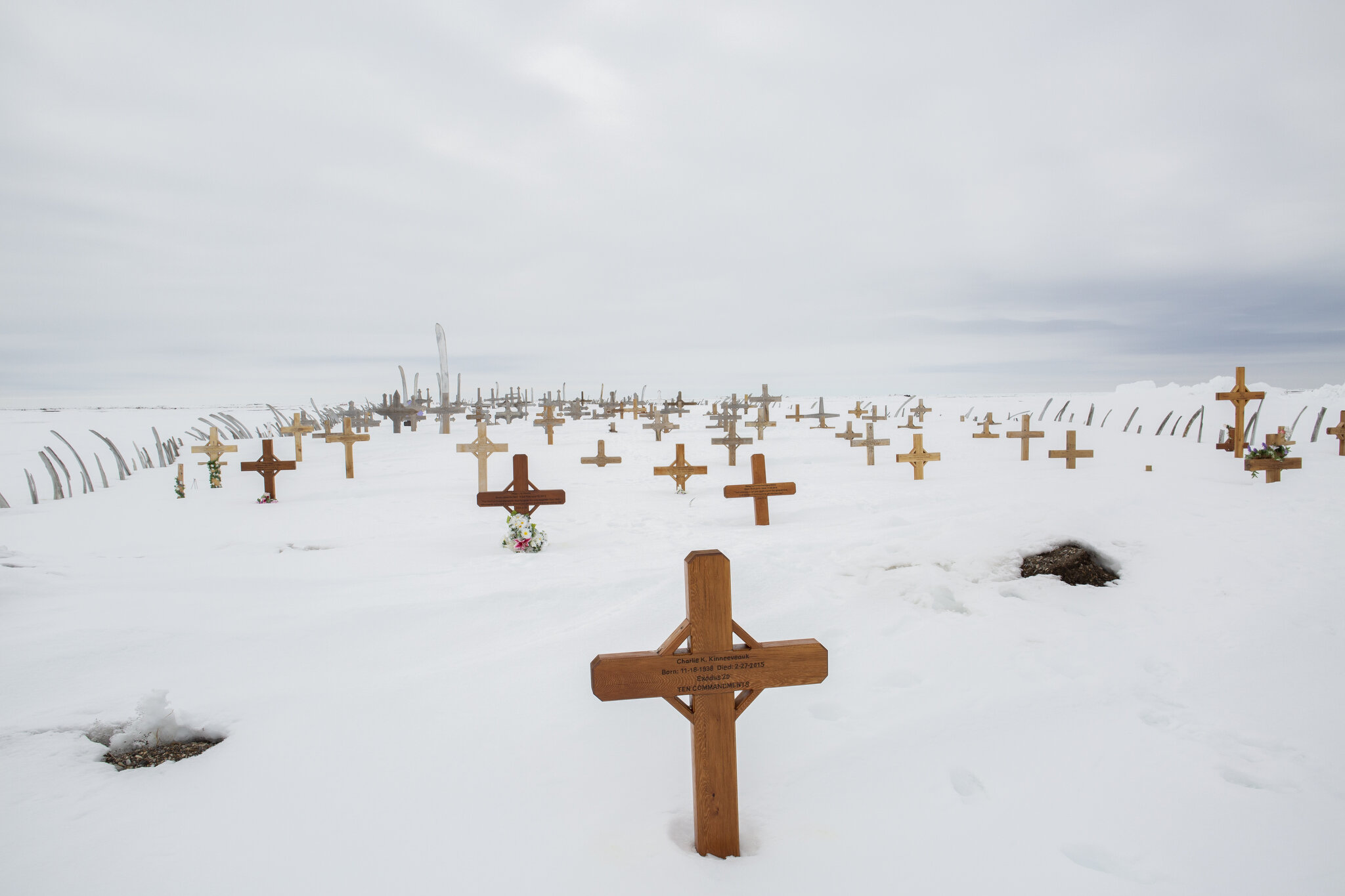
The cemetery for whaling captains in Point Hope, Alaska. May 8th, 2015. The cemetery fence is made of bleached whale bones. According to the Arctic Slope Regional Corporation, Point Hope is the longest continually inhabited community in North America, and for the people of Point Hope, nothing is more important than the bowhead whale. Their calendar year revolves around hunting, fishing and gathering, a lifestyle Alaskans call “subsistence,” which is as much cultural tradition as dietary and economic necessity. This tradition is at risk as a result of climate change; erosion and thawing permafrost are destroying ice cellars that store the meat while at the same time eating up the landscape, making travel and hunting increasingly dangerous on the fragile, shifting ground. Meanwhile permafrost thaw is damaging everything from ice cellars and infrastructure, to cemeteries.
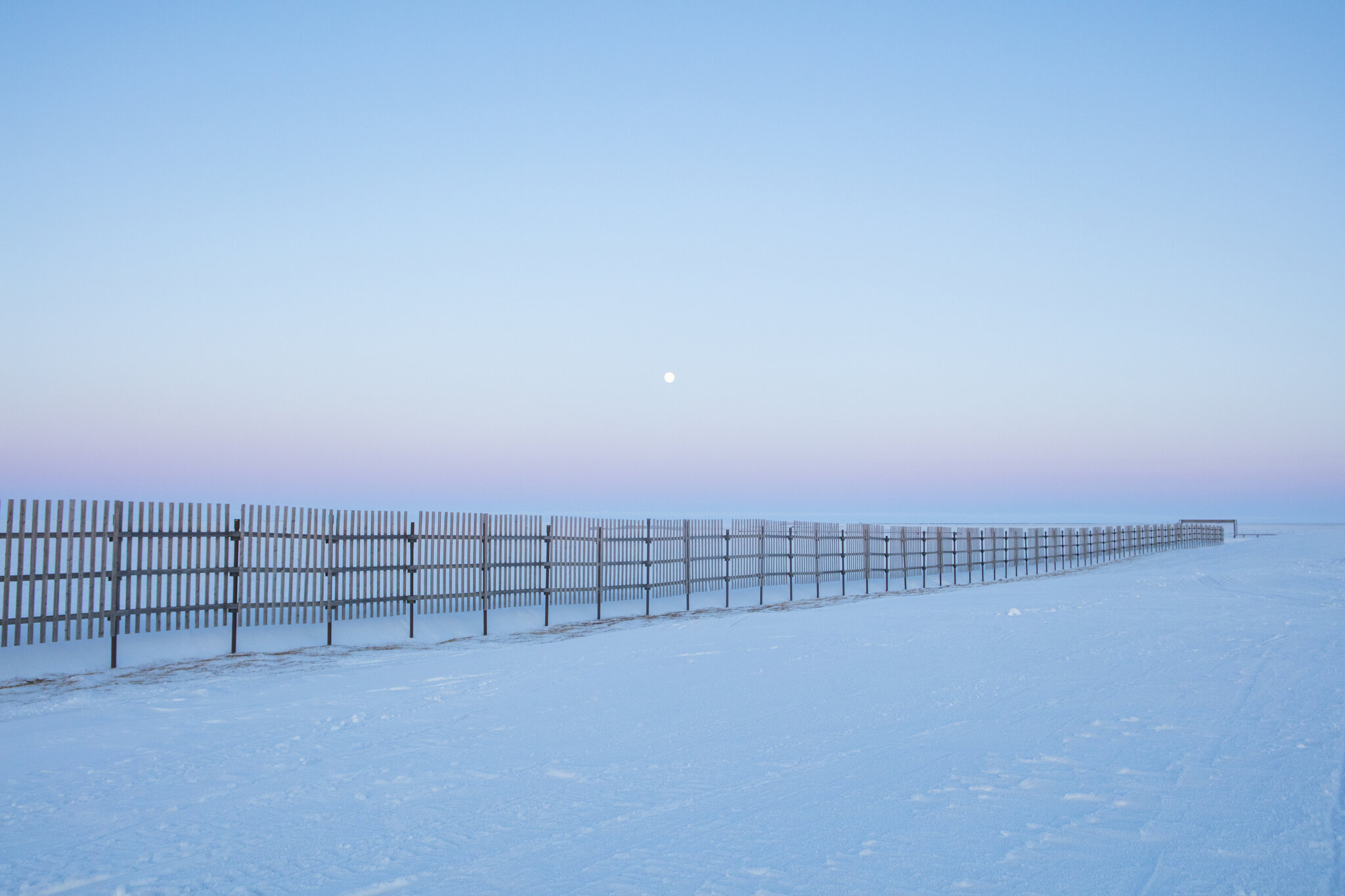
A snow fence in Utqiagvik, Alaska, is meant to provide protection from the threat of winter storms that can engulf the entire village in snow drifts. April 29th, 2018 Extreme weather events are becoming increasingly common, as warming weather and melting sea ice transform the Arctic’s climate. Meanwhile, building this kind of necessary infrastructure is challenged by shifting ground caused by thawing permafrost.
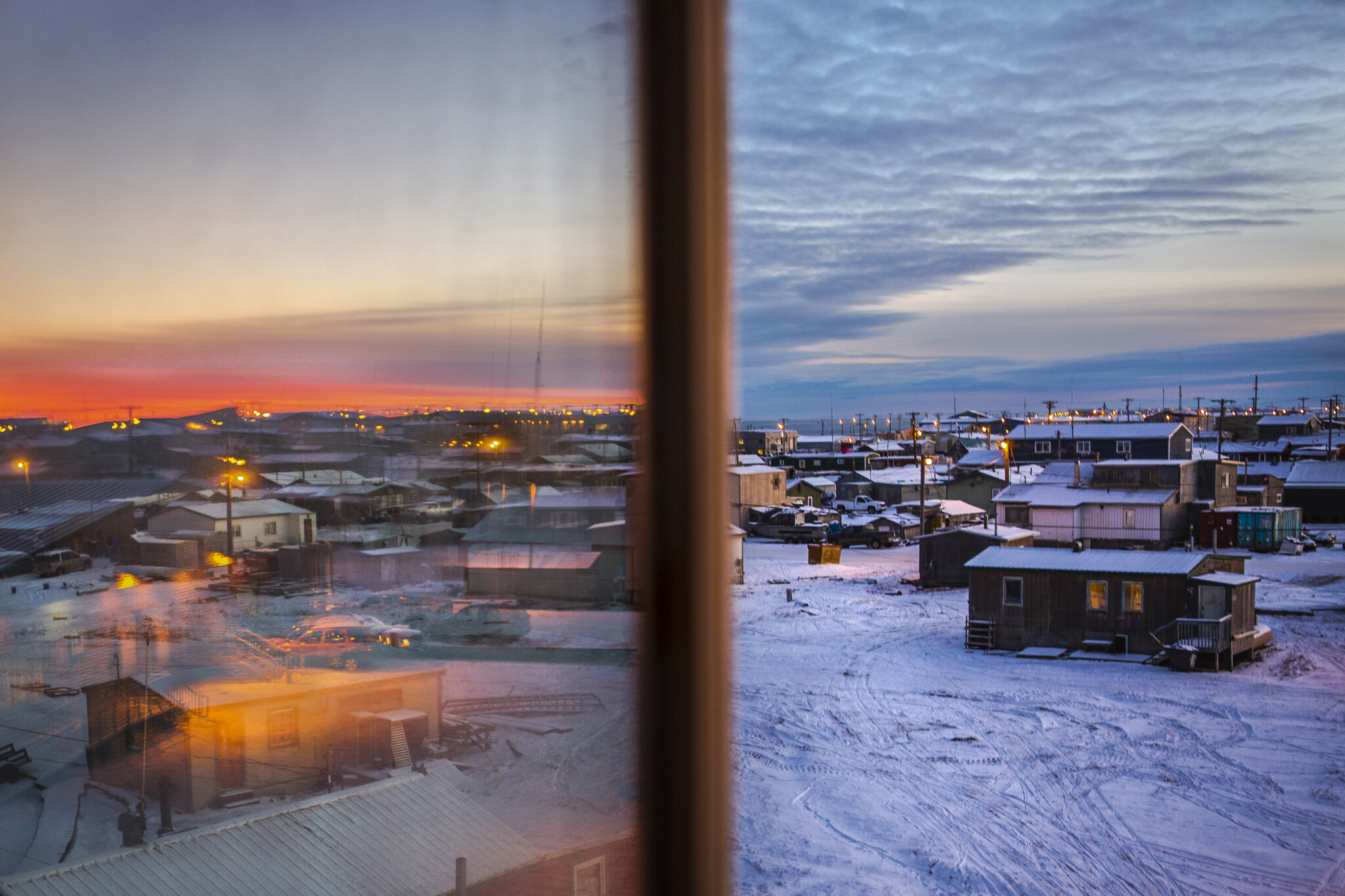
Utqiagvik, Alaska, formerly known as Barrow. October 16th, 2015. July 2019 was officially the warmest month in Alaskan history, and Utqiagvik, the northernmost town in the United States, has been labeled “ground zero for climate change.”
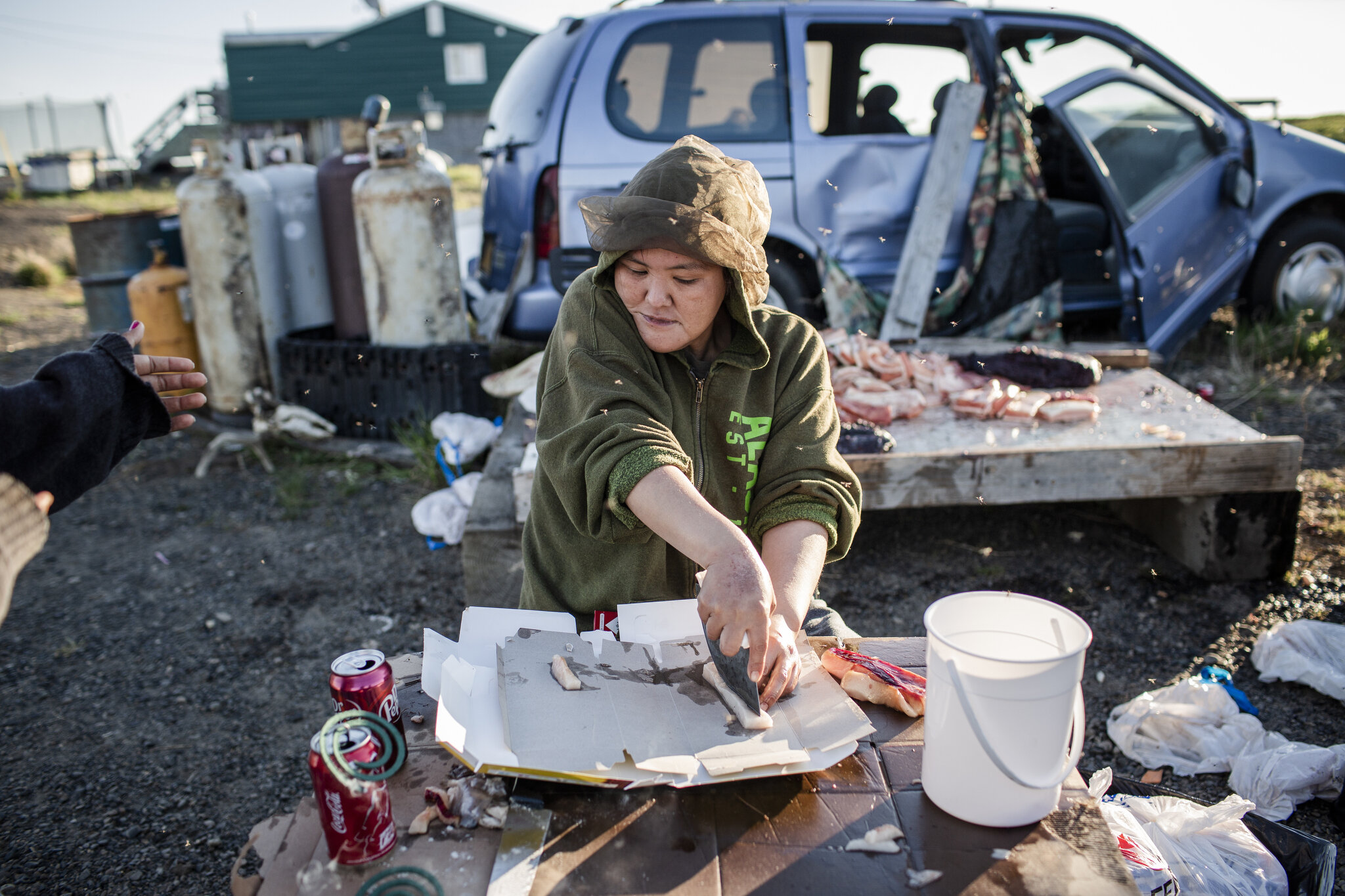
A woman processes beluga whale after days of harvesting the food source in Point Lay, Alaska, a tiny, isolated Inupiat village with a population of roughly 250 people located along the Chukchi Sea. June 23rd, 2015. Point Lay has become well known as the location where an estimated 35,000 walrus annual fall time "haul out." These at-risk animals lumber out of the sea and congregate on shore, a change in their long-term behavior patterns that has been linked to shrinking Arctic sea ice related to climate change.
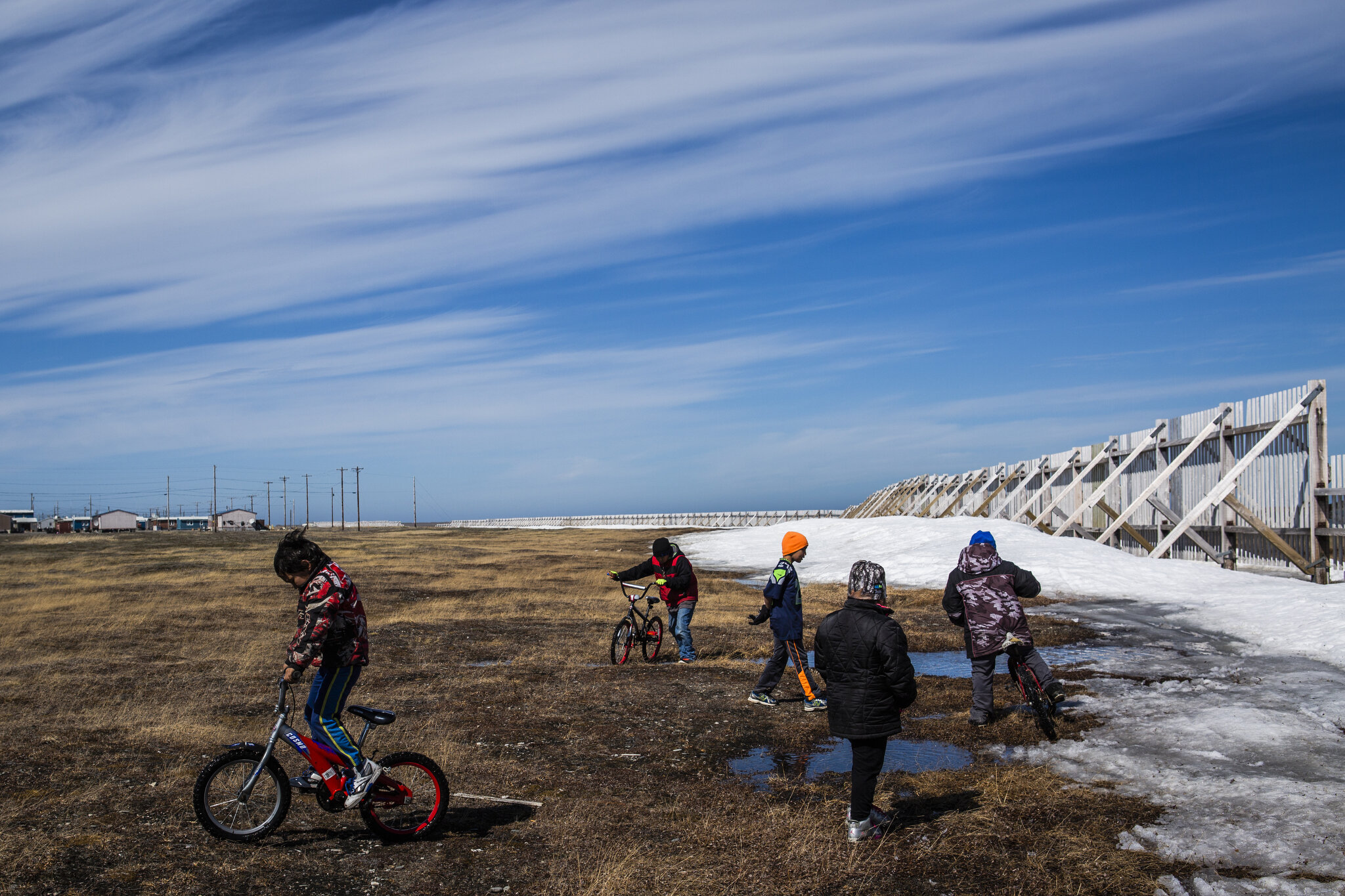
Children play along the edges of the annual whaling feast celebration in Point Hope, Alaska. To the children’s right lies a snow fence meant to protect from winter storm surges engulfing the village, and underneath their feet rests an invisible threat-thawing permafrost threatening the community's fragile tundra landscape. June 15th, 2015. According to the Arctic Slope Regional Corporation, Point Hope is the longest continually inhabited community in North America, and for the people of Point Hope, nothing is more important than the bowhead whale. Their calendar year revolves around hunting, fishing and gathering, a lifestyle Alaskans call “subsistence,” which is as much cultural tradition as dietary and economic necessity. This tradition is at risk as a result of climate change; erosion and thawing permafrost are destroying ice cellars that store the meat while at the same time eating up the landscape, making travel and hunting increasingly dangerous on the fragile, shifting ground.
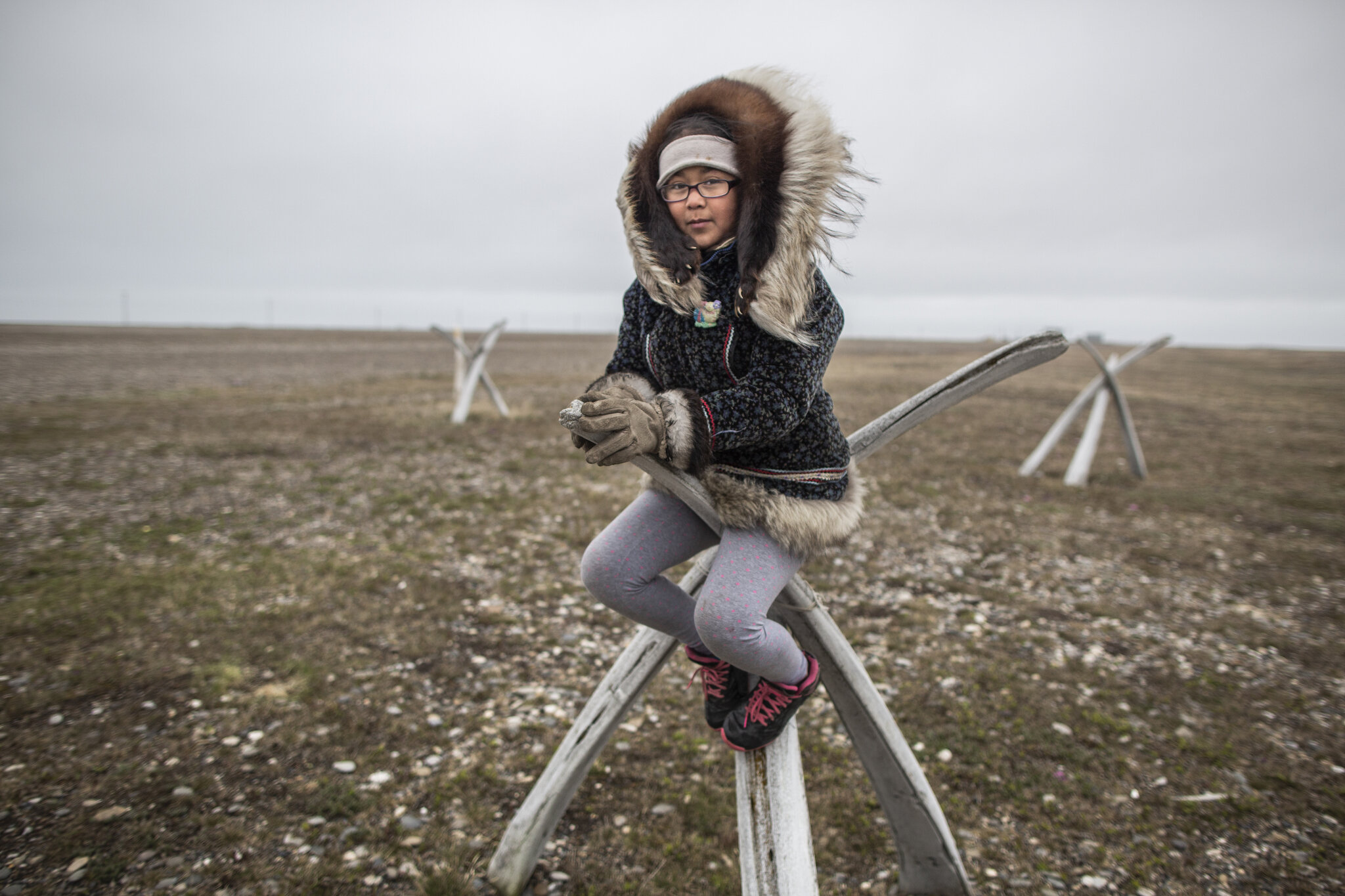
A girl watches the traditional blanket toss at the annual whaling feast in Point, Hope Alaska while perched on top of dried out whale bones. June 14th, 2015. According to the Arctic Slope Regional Corporation, Point Hope is the longest continually inhabited community in North America. For the people of Point Hope, nothing is more important than the bowhead whale. The calendar year revolves around hunting, fishing and gathering, a lifestyle Alaskans call “subsistence,” which is as much cultural tradition as dietary and economic necessity. This tradition is at risk as a result of climate change; erosion and thawing permafrost are destroying ice cellars that store the meat while at the same time eating up the landscape, making travel and hunting increasingly dangerous on the fragile, shifting ground.
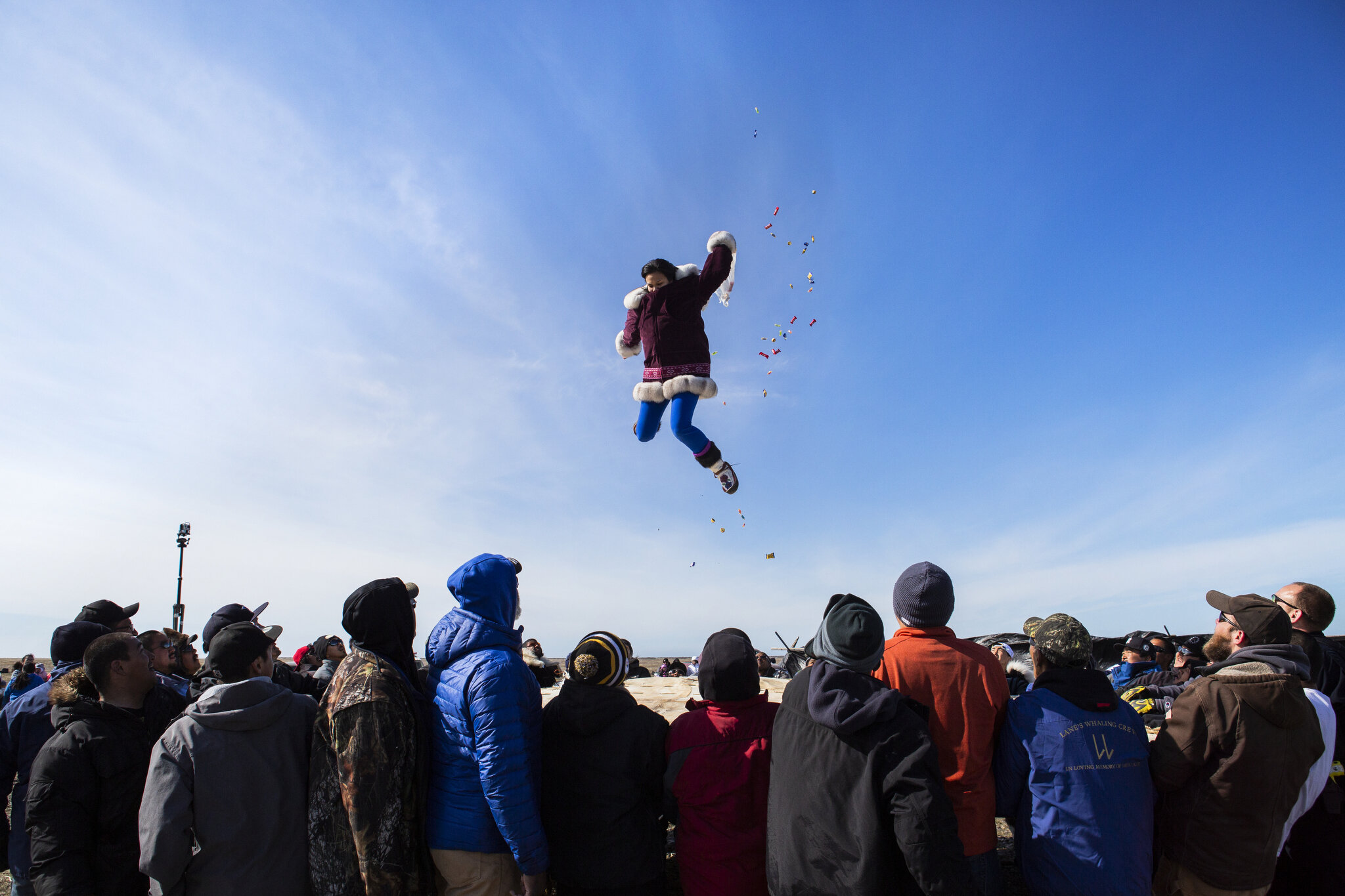
The Nalukataq, or blanket toss, in Point Hope, Alaska. The blanket toss is a celebratory Iñupiat tradition, originating from long ago when hunters would get launched into the air on what was (and still is) a giant trampoline made out of seal skins in order to catch a glimpse of far-distant prey. This traditional blanket toss was held at Point Hope’s annual whaling feast celebration. June 6th, 2015. According to the Arctic Slope Regional Corporation, Point Hope is the longest continually inhabited community in North America, and for the people of Point Hope, nothing is more important than the bowhead whale. Their calendar year revolves around hunting, fishing and gathering, a lifestyle Alaskans call “subsistence,” which is as much cultural tradition as dietary and economic necessity. This tradition is at risk as a result of climate change; erosion and thawing permafrost are destroying ice cellars that store the meat while at the same time eating up the landscape, making travel and hunting increasingly dangerous on the fragile, shifting ground.
PROJECTS
Chasing Winter
By Katie Orlinsky
Scientists call the Alaska “ground zero” for climate change, and last year was the state’s warmest on record. Alaska is at the front line of climate change and what is happening to villages across the region can be seen as early indications for the rest of the world’s future. “Chasing Winter” explores how this reality is transforming the relationship between people, animals, and the land.


